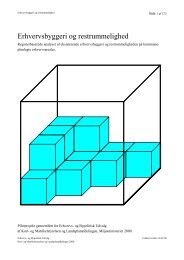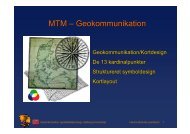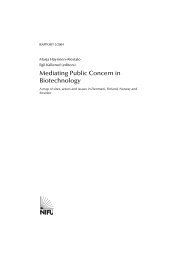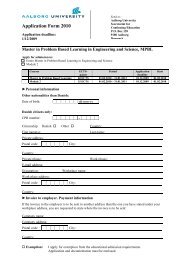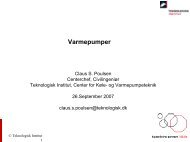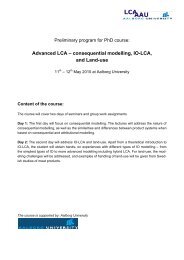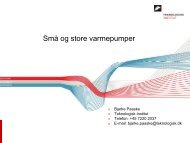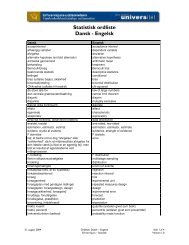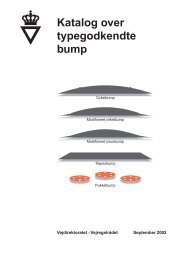Towards a Mobile Tourist Information System: Identifying ... - Agile
Towards a Mobile Tourist Information System: Identifying ... - Agile
Towards a Mobile Tourist Information System: Identifying ... - Agile
Create successful ePaper yourself
Turn your PDF publications into a flip-book with our unique Google optimized e-Paper software.
10th AGILE International Conference on Geographic <strong>Information</strong> Science 2007<br />
Aalborg University, Denmark<br />
INTRODUCTION<br />
<strong>Towards</strong> a <strong>Mobile</strong> <strong>Tourist</strong> <strong>Information</strong> <strong>System</strong>:<br />
<strong>Identifying</strong> Zones of <strong>Information</strong> Relevance<br />
Lasse Møller-Jensen & Jens Egler Hansen<br />
Department of Geography, University of Copenhagen<br />
A gps-enabled GIS acting as a mobile traveller information system is described in Møller-Jensen,<br />
2005. In general terms the objective of the system is to present attribute information of the<br />
surroundings to a traveller in motion. It is done automatically and in accordance with the speed and<br />
direction taken relative to objects represented in the GIS. The system specification is based on the<br />
assumption that the user does not handle the system interactively by clicking on the map (e.g. because<br />
he or she is engaged in driving) and furthermore that a stream of relevant information about the<br />
surroundings – adapting to the movements of the user – should enhance the travel experience by<br />
providing interesting knowledge within a user-specified domain.<br />
The attribute presentation is in this situation subjected to time and space constraints which are a<br />
function of the time necessary to present the information compared to the speed of movement and the<br />
length of the stretch of road where the information is relevant. Moreover, several objects may be<br />
eligible for presentation within the same segment of the travel path. The system specification includes<br />
strategies for handling these situations by possibly excluding information or by data generalization on<br />
the attribute level controlled by an imbedded ontology. One of the general benefits of the system is its<br />
potential adaptation to different languages and knowledge type preferences which may help to provide<br />
a better service to tourists with different cultural backgrounds.<br />
At present, the main application of small computers with GIS/GPS capabilities is within mobile<br />
navigation. Few papers have described efforts to further utilize the potential ability of the mobile GIS<br />
to provide elaborate attribute information about any object that a user interacts with while moving<br />
around. Frank et. al. (2004) describes a transformation of the traditional GIS into a Location Based<br />
Service by providing mobility, distributiveness and egocentric awareness. The general problem of<br />
selecting the physical object for which to receive information in a given spatial context (equal to the<br />
human action of pointing) has been examined by Egenhofer (2003). Current solutions are still mostly<br />
of an experimental nature and assume availability of special equipment such as directions sensors or<br />
advanced pointing devices. Nevertheless, some systems restricted to confined locations such as<br />
cultural or entertainment sites have been implemented in practice. IST (2004) describes how GPSenabled<br />
city guides are already used in the travel industry and argues that especially the “culture and<br />
history travel market” will be able to benefit from a strategy towards location-sensitive presentation<br />
of object information.<br />
The current study focuses on two interrelated issues that need to be addressed as part of an effort<br />
to implement a successful information system. The first issue is the selection and categorization of<br />
objects for presentation and the second is the definition of the spatial scope of the information<br />
relevance for each object (termed the relevance segment). The overall goal is to initiate the presentation<br />
when the traveller reaches an appropriate position relative to the object.<br />
This study is mainly related to movements in free air – other considerations may be relevant when<br />
focusing on mobile information systems for use inside museums. An important consideration is how<br />
to potentially support ’spatial narratives’ by providing guidance that allows the user to visit objects in<br />
a desirable sequence e.g. for better understanding of time periods or processes.<br />
Page 1 of 7
10th AGILE International Conference on Geographic <strong>Information</strong> Science 2007<br />
Aalborg University, Denmark<br />
OBJECT SELECTION AND INFORMATION RELEVANCE<br />
Is it evident that a distinction exists between providing knowledge concerning – on the one hand –<br />
objects that are expected to attract the attention and curiosity of the traveller due to their visible<br />
appearance and – on the other hand – providing new knowledge that will enhance the traveling<br />
experience of the user by providing information about objects that would otherwise not be noticed –<br />
or at least not be associated with the additional information. It is evident that objects that attract<br />
attention due to their appearance may also often have equally interesting ’hidden’ properties. Table 1<br />
provides examples of objects that fall into the two categories.<br />
Object characteristics: Examples:<br />
Visibly interesting<br />
(due to appearance)<br />
Invisibly interesting<br />
(due to history connected with<br />
object)<br />
monuments, churches, towers, castles, vegetation species with<br />
distinctive features,<br />
- buildings previously occupied by a famous person,<br />
- places of historic events, e.g. battlefields, squares,<br />
- historic locations with no landmarks: ’this is where the old<br />
gate of the city was located’<br />
- other special points, e.g. the geometric center of gravity of a<br />
municipality or country<br />
- properties of an urban area (e.g. building period)<br />
Table 1: Examples of surrounding objects with different characteristics concerning attraction.<br />
The first situation can be handled both by interactive systems that require the traveller to request<br />
the information and by automatic systems that react to the speed and location of the traveller. The<br />
second situation, however, can only be handled by systems that automatically present the information<br />
at the relevant speed and location.<br />
It is not unreasonable to assume that a mobile information system focusing on the latter<br />
functionality would be able to provide benefits to travellers that would not have been possible without<br />
the GPS/mobile-GIS integration. It could ’open up a new world’ of spatially-related information<br />
within specific domains specified by the traveller and thereby provide new insight and interests in<br />
objects and areas that would otherwise have been perceived as uninteresting. As exemplified in table<br />
1, some of the information that falls in this category may not be connected to a physical object that<br />
has any specific relation to the information. It is left to the imagination of the traveller to connect the<br />
information to the actual surroundings in such cases.<br />
Are there reasons to treat these two categories of objects differently when it comes to identifying<br />
the best place to present the information? Does it play a role whether the object is actually visible<br />
from the visitor’s position or not? These two questions are discussed below.<br />
Page 2 of 7
10th AGILE International Conference on Geographic <strong>Information</strong> Science 2007<br />
Aalborg University, Denmark<br />
RELEVANCE ZONES - VISIBILITY OR PROXIMITY<br />
A major consideration is how to define the zones of information relevance for each object<br />
represented in the system. In case of road-based traveling this concept refers to specific stretches of<br />
road – in the following termed R-segments. Attribute information about an object could be presented<br />
anywhere along its corresponding R-segment(s). See also figure 1.<br />
Figure 1: Locations of R-segments and I-segment illustrated for an object surrounded by two<br />
roads. R-segments indicate the stretches of road where information presentation is relevant. The Isegment<br />
is related to the speed of a specific traveller and indicates the road travelled during the<br />
presentation.<br />
The actual location for the presentation (termed the I-segment) depends on the speed of travel and<br />
whether the duration of the presentation relative to the length of the R-segment allows for it. If aiming<br />
for an automatic procedure, R-segments may be identified using either proximity analysis, visibility<br />
analysis or both. Visibility analysis determines the stretches of road from which the object is visible<br />
while proximity analysis identifies stretches of road within a certain Euclidean distance. The two<br />
types of analyses are discussed further below.<br />
Table 2 illustrates a relevant distinction between a situation where the traveller is able to see an<br />
object and a situation where this is not the case either because the line of sight is blocked or because<br />
there is no physical land mark to see as discussed above. Visibility analysis is appropriate in all cases<br />
of visible objects while proximity analysis is used to handle the situation where the traveller is close<br />
to the object without being able to see it.<br />
Page 3 of 7
10th AGILE International Conference on Geographic <strong>Information</strong> Science 2007<br />
Aalborg University, Denmark<br />
Object characteristics: Visible object Invisible object<br />
Visibly interesting<br />
(due to appearance)<br />
Invisibly interesting<br />
(due to history connected<br />
with object)<br />
object catches attention of traveller<br />
and creates curiosity that is<br />
satisfied by attribute information<br />
(object visibility analysis is<br />
relevant)<br />
system makes traveller aware that a<br />
nearby common object is of<br />
interest by providing attribute<br />
information (object visibility<br />
analysis is relevant)<br />
line of sight is blocked from<br />
the current traveller location:<br />
system makes traveller aware<br />
of object presence and<br />
provides attribute<br />
information (proximity<br />
analysis is relevant)<br />
line of sight is blocked or<br />
there is no physical land<br />
mark (proximity analysis is<br />
relevant)<br />
Table 2: Object types, visibility and relevant method for computing R-segments.<br />
A given (visible) object may be visible from some road segments and close to -but invisible from-<br />
other road segments. Since the system must handle any user location (and travel speed), it follows that<br />
it is necessary to perform both visibility analysis and proximity analysis for all objects. An exception<br />
may be the objects that do not have a physical land mark and only appear as GIS points that mark a<br />
historic event. In this case one may either rely on proximity analysis or perform the visibility analysis<br />
by introducing an ’imaginary’ physical object placed at the specific point and of a suitable size and<br />
shape.<br />
VISIBILITY ANALYSIS<br />
The basic task of identifying stretches of road that are near to a given object is a fairly straightforward<br />
GIS process: Standard buffer zones may be applied to extract the road segments within a<br />
specific Euclidean distance. The distance chosen must reflect the physical appearance of the object,<br />
the type and significance of the information and the density of objects within the area. The current<br />
presentation, however, focuses primarily on various aspects of the visibility analysis based on the<br />
experiences from a case study.<br />
The aim of the study is to analyze whether the visibility-based R-segments can be identified<br />
automatically using raster-gis methods. The first step is to establish a digital surface model of the<br />
area. It is recognized that a digital surface model based on laser scanning may be appropriate for these<br />
tasks but none were available for the area at the time of the study. A digital terrain model has been<br />
used instead. A number of physical objects of varying height and size have been identified in the area.<br />
The areas from which each object is visible have been calculated using the function ‘viewshed’ in<br />
ArcMap (ESRI,2006). The visibility areas are subsequently overlayed on the road map to provide the<br />
visibility boundaries. Figure 2 shows the results of a sub region of the study area.<br />
Page 4 of 7
10th AGILE International Conference on Geographic <strong>Information</strong> Science 2007<br />
Aalborg University, Denmark<br />
Figure 2: The green areas ‘radiating’ from the object “Øm jættestue” (ancient passage grave)<br />
in the middle indicate areas from which the object is visible.<br />
RESULTS<br />
The results indicate a number of issues to be addressed:<br />
1. The visibility areas take very irregular shapes due to the many small hills in the area, see figure<br />
2. As a result, the R-segments identified by the overlay process are split into several parts with gaps in<br />
between. In some cases, these gaps are small relative to the total length of the R-segments, and should<br />
probably be ignored during the process of identifying the place to start presentation. A robust<br />
algorithm for eliminating gaps within this context is required.<br />
2. As it is the case in fig 1, an object may be visible from several roads. A large R-segment on one<br />
road would allow for a longer information which would not ’fit’ onto another road with a shorter Rsegment<br />
given the same travel speed. In this case the traveller must either move slower or the length<br />
of the information must be adapted to the shorter R-segment in the design phase.<br />
3. When is the appropriate time to actually present the information? The current system works<br />
under the assumption that the midpoint of the R-segment is the best time to place the I-segment. Field<br />
experiments have shown that this is not necessarily the case. In many cases, it seems more in<br />
accordance with user preferences to present the information when the object is first spotted, i.e. at one<br />
Page 5 of 7
10th AGILE International Conference on Geographic <strong>Information</strong> Science 2007<br />
Aalborg University, Denmark<br />
of the extreme ends of the R-segment. A process involving manual assessment would probably<br />
identify other specific points within the R-segments to be the best anchor points based on local<br />
conditions concerning road direction, object shape and angle that would be difficult to incorporate<br />
into the GIS analysis.<br />
4. Comparing with real life experiences, it is clear that the actual visibility of an object depends<br />
on more than the terrain morphology between the observer and the object. Permanent or temporal<br />
man-made objects and vegetation play an important role that is difficult to account for through an<br />
automatic method. The raster-based visibility analysis would probably provide more suitable results if<br />
performed on a laser scanned digital surface model which will be the subject of future research.<br />
5. It is worth comparing the concept of visibly interesting objects for tourist information with the<br />
concept of salience of features applied by f.ex. Klippel & Winter (2005) and Nothegger et al. (2004)<br />
within the context of automatic identification of landmarks for providing navigation support. One<br />
difference is the need for the route description algorithm to find objects on-the-fly that – for some<br />
reason - “stand out” relative to their close surroundings, while the objects represented in the tourist<br />
information system would be a priori classified as of absolute interest within a specific domain. It<br />
may be highly relevant, however, to consider applying the methods for identifying feature salience<br />
within the information system context also in order to find objects that will attract the attention of<br />
travellers exclusively due to their appearance within the local neighbourhood.<br />
BIBLIOGRAPHY<br />
Egenhofer, M.; 2003 A family of smart maps In Timpf S: (Ed). Euresco Conference on Geographical<br />
Domain and Geographical <strong>Information</strong> <strong>System</strong>s. ESF. Bad Herrenalb.<br />
ESRI, 2006 Documentation for the Viewshed function of the 3d-analyst extension. ESRI, Redlands,<br />
2006.<br />
Fonseca, F., Davis C, Camara G., 2003 Bridging Ontologies and Conceptual Schemas in Geogarphic<br />
Applications Development. Geoinformatica: 7(4)<br />
Frank, C., Caduff, D., Wuersch, M., 2004 From GIS to LBS – An Intelligent <strong>Mobile</strong> GIS. IfGI prints<br />
Vol. 22 Münster<br />
IST 2004 Location-Based Services in the Culture and History Travel Market. Intelligent Spatial<br />
Technologies. White Paper.<br />
Kulik, L., Duckham, M., Egenhofer, M., 2005 Ontology-driven map generalization. Journal of Visual<br />
Languages and Computing 14 (5) 469-492<br />
Klippel, A.; Winter, S., 2005: Structural Salience of Landmarks for Route Directions. In: Mark, D.M.;<br />
Cohn, T. (Eds.), Spatial <strong>Information</strong> Theory. Lecture Notes in Computer Science,<br />
Springer, Berlin.<br />
Kwan, K., Shi, W., 2002 A study of dynamic database in <strong>Mobile</strong> GIS. Symposium on Geospatial<br />
Theory, Processing and Applications, Ottawa<br />
Møller-Jensen, L., 2005 <strong>Mobile</strong> GIS - attribute data presentation under time and space constraints. pp.<br />
234-241 in: GeoSpatial Semantics - First International Conference, GeoS 2005, Mexico<br />
City, M. Andrea Rodríguez, Isabel F. Cruz, Max J. Egenhofer & Sergei Levashkin (ed.). -<br />
Lecture Notes in Computer Science, vol- 3799, Berlin: Springer<br />
Nothegger, C., Winter, S., Raubal, M. 2004 Selection of salient features for route directions. Spatial<br />
Cognition and Computation 4 (2): 113-136<br />
Page 6 of 7
10th AGILE International Conference on Geographic <strong>Information</strong> Science 2007<br />
Aalborg University, Denmark<br />
Weibel, R., Dutton, G., 1999 Generalizing spatial data and dealing with multiple representations, In;<br />
Longley P.A., Goodchild M.F., Maguire D.J., Rhind D.W.: Geographical <strong>Information</strong><br />
<strong>System</strong>s – Principles and Technical Issues Vol I Chap 10<br />
Winter, S. & Tomko, M., 2004: Shifting the focus in <strong>Mobile</strong> maps. Proc. UPIMap2004. 7-9<br />
Septmber. Tokyo.<br />
Page 7 of 7





